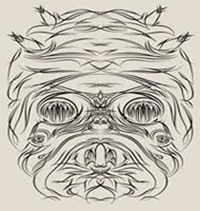Pin striping
Pin striping describes the application of a pin stripe: a very thin line of paint or other material, generally used for decoration.
In automotive body work, pin stripes can either be a thin vinyl tape or paint. The tape versions are adhered directly to the painted surface in the pattern desired, while painted ones are done by skilled artists with specialized brushes. The goal of pin striping is to enhance the contours of the surface, and the lines are generally of a complementary color. In any other form of decorative pin stripes, the goal is the same.
It can also describe a pattern of very thin stripes running in parallel found in cloth. Although mostly found in men's suits, any type of clothing can be pin striped. The New York Yankees baseball team's uniforms have had pin stripes for nearly 100 years.
Pin striping is defined as a thin line of color on a contrasting background. Pin stripes are a pattern in cloth, but pin striping technique usually refers to the application of decorative paint on vehicles or rarely in furniture. Pin striping requires a solid hand and some special skills and equipment.




There are three basic techniques to pin striping.
Mechanical Pin Striping Machines:
Stencil Tape:
Freehand Pin Striping:
A mechanical pin-striping machine controls the paint application and breadth of the stripe, allowing the operator to concentrate on the placement of the line. Mechanical pin-striping machines can also take benefits of magnetic auto pin-striping strips. This strip attaches to the body of the car, allowing the operator to adjust the strips to make sure the whole thing is straight before the mechanical pin-striping machine applies the paint along the strip. Magnetic strips can also be bent, resulting in more artistic pin stripes.
Place stencil tape on the car as a direct for the pin stripe paint. The stencil tape allows adjustments to be made before paint is applied. In this tapes also allow the application of multiple colors. Stencil tape is offered at paint specialty shops and offers a lower-cost alternative for do-it-yourself pin striping that still yields excellent results.
The most creative technique of pin striping is freehand pin striping. Freehand pin stripers often place a piece of masking tape about a sector inch from the planned location of the pin striping. The masking tape cannot be used as an edging for the pin stripe because the paint may seep under the tape and give the pin stripe a tattered edge. Freehand pin striping does offer some compensation.







